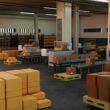The iPhone’s screen is one of its most distinguishing features and has a major impact on how the device is used. In order to get the most out of their devices, consumers need to familiarise themselves with the many types of displays available. This article delves into iPhone LCDs, including their value, typical problems, available fixes, recommended upkeep, and more.
Understanding iPhone LCD
What is an LCD?
A liquid crystal display, or LCD. It’s a method for creating visuals on a flat surface by means of liquid crystals. The display is made possible by liquid crystals that, when hit by an electric current, rearrange themselves to either block or let through light.
How does an LCD work?
A polarising filter, liquid crystal cells, colour filters, and a backlight are just some of the components that make up the iPhone LCD. The desired colours and images are created when light from the backlight is transmitted through the colour filters and liquid crystal cells. The polarising filter is useful for regulating the path of incoming light.
LCD vs. OLED: Key differences
The two most common types of mobile phone displays are liquid crystal displays (LCD) and organic light-emitting diodes (OLED). In contrast to LCDs, which rely on a backlight, OLEDs generate light independently for each pixel. Variations in contrast, black levels, power usage, and cost all stem from this underlying dissimilarity.
The Importance of iPhone LCD Quality
An iPhone with a high-quality LCD helps provide a more compelling and satisfying experience. Some examples of why this is so crucial are as follows:
Display resolution and clarity
The clarity and sharpness of an iPhone’s LCD are dependent on its resolution. Text, photos, and videos all benefit from a sharper quality, making the device more enjoyable to use.
Color accuracy and vibrancy
The iPhone’s display improves the device’s aesthetic appeal with its vibrant and true-to-life colours. The result is a more lifelike appearance in both still images and moving pictures. Professionals that rely on colour-critical tasks, like photo editing and graphic design, have a heightened need for accurate colour representation.
Impact on battery life
Smartphones’ batteries tend to die quickly because of the screen’s constant use. iPhones with LCD panels are less draining on the battery than other smartphones’ displays. Power efficiency is critical for iPhone users who rely on their devices constantly.
Common iPhone LCD Issues
iPhone LCDs are generally reliable; however, there are a few issues that can arise. Some of the most frequent complaints from customers are as follows:
Dead pixels
Dead pixels are malfunctioning display elements that fail to light up. They detract from the visual experience as tiny black or coloured spots. A single or two dead pixels may not be distracting, but a cluster of them will.
Backlight bleeding
Backlight bleeding happens when an LCD panel’s backlight is not uniformly distributed. This problem usually manifests itself in darker scenes or when reading content with a black background, reducing the overall display quality.
Touch screen responsiveness
iPhone LCDs can have issues with touch sensitivity. Touch detection may be sluggish or imprecise, making it hard to use apps or complete gestures without a hitch.
LCD Repair and Replacement Options
The iPhone’s LCD can be repaired or replaced in a few different ways:
DIY repairs
DIY fixes are an option for the technically adept. It is possible to get comprehensive tips and tutorials for replacing an LCD screen online. While it may be tempting to try fixing something yourself, it’s crucial to remember that doing so without the necessary expertise might cause more harm or even violate warranties.
Third-party repair services
Expert iPhone LCD repair services are available from third parties. The prices for these services are typically lower than those at official Apple repair locations. In need of repairs? Go with a company you can trust to use excellent replacement components and stand by their work with a warranty.
Authorized Apple service centers
If you care about official support and maintaining the validity of your warranty, your best bet is to visit an Apple Authorised Service Provider. Expert technicians at these locations can identify and fix iPhone LCD issues with original equipment.
Tips for Maintaining iPhone LCD
Follow these guidelines to extend the life of your iPhone’s display and improve its functionality:
Use a screen protector
A screen protector can prevent the LCD from being damaged by fingerprints, smudges, and drops. Protective films and tempered glass are only two of the many options for your screen.
Avoid exposing the device to extreme temperatures
The functionality and durability of an LCD may be compromised by exposure to extreme temperatures. It’s not good to leave your iPhone in the car on a hot day or in the freezer overnight.
Handle the iPhone with care
The LCD and other internal components are vulnerable to damage from accidental drops and collisions. Careful handling, a protective case, and gentle use can prevent damage to the iPhone’s LCD.
The iPhone’s LCD is a key component in the device’s ability to deliver a remarkable user experience. Users may make better decisions and extend the life of their devices by learning about the inner workings of LCD technology, identifying frequent concerns, and understanding repair and replacement alternatives.




